Management of Wild Edible Fungi in the Meseta Purépecha Region, Michoacán, México
Abstract
:1. Introduction
2. Materials and Methods
2.1. Study Area
2.2. Qualitative Analysis
2.3. Collection, Preservation, and Identification of Fungi Specimens
2.4. Community Feedback
3. Results and Discussion
3.1. Paracho Municipal Market
3.2. Ethnoecology of Mushrooms in Cherán, Michoacán
3.2.1. Corpus: Environmental Knowledge
Terekua, Jongo, and Jeramba
Purépecha Nomenclature of Edible Fungi, Species Richness, and Preferences
3.2.2. Praxis: Management and Harvesting Techniques
Fungi Management and Harvesting Techniques
3.2.3. Purépecha Kosmos and the Community’s Relationship with the Forest
3.3. Problems and Possible Solutions in the Management and Consumption of Fungi
4. Conclusions
Author Contributions
Funding
Acknowledgments
Conflicts of Interest
References
- MacNeish, R. The Origins of Agriculture and Settled Life; Norman and University of Oklahoma Press: Norman, OK, USA, 1992. [Google Scholar]
- Toledo, V.M.; Barrera-Bassols, N. La Memoria Biocultural. La Importancia Ecológica de las Sabidurías Tradicionales; Icaria Editorial: Barcelona, Spain, 2008. [Google Scholar]
- Moreno-Calles, A.I.; Casas, A.; Rivero-Romero, A.D.; Romero, Y.; Fisher Ortíz, R.A.; Alvarado, F.; Vallejo, M.; Santos-Fita, D. Ethnoagroforestry: Integration of biocultural diversity for sovereignty (food) in México. J. Ethnobiol. Ethnomed. 2016, 12, 2–21. [Google Scholar] [CrossRef] [PubMed]
- Toledo, V.M.; Alarcón-Chaires, P. La etnoecología hoy: Panorama, avances, desafíos. Etnoecologíca 2012, 1, 1–16. [Google Scholar]
- Wolverton, S. Ethnobiology 5: Interdisciplinarity in an era of rapid environmental change. Ethnobiol. Lett. 2013, 4, 21–25. [Google Scholar] [CrossRef]
- Mapes, C.; Guzmán, G.; Caballero, J. Elements of the Purépecha mycolgical classification. J. Ethnobiol. 1981, 2, 231–237. [Google Scholar]
- Ruan-Soto, F.; Garibay, O.; Cifuentes, J. Conocimiento micológico tradicional en la planicie costera Golfo de México. Rev. Mex. Micol. 2004, 19, 57–70. [Google Scholar]
- Gómez-Reyes, V.; Gómez-Peralta, M.; Ortega-Varela, Z. Hongos silvestres comestibles de la comunidad indígena Nicolás Romero, Zitácuaro, Michoacán. Biológicas 2005, 7, 31–38. [Google Scholar]
- Alarcón-Cháires, P. Etnoecología de los Indígenas P´urhépechas: Una Guía Para el Análisis de la Apropiación de la Naturaleza; IIES, UNAM: Morelia, Mexico, 2009; pp. 50–76. [Google Scholar]
- Moreno-Fuentes, A. Un recurso alimentario de los grupos originarios y mestizos de México: Los hongos silvestres. An. Antropol. 2014, 48, 241–272. [Google Scholar] [CrossRef]
- Guzmán, G. Análisis cualitativo y cuantitativo de la diversidad de los hongos en México. In La Diversidad Biológica de Iberoamérica II; Halffter, G., Ed.; Acta Zoológica Mexicana, Volumen Especial; CYTED, Instituto de Ecología: Xalapa, Mexico, 1998. [Google Scholar]
- Guzmán, G. Inventorying the fungi of México. Biodivers. Conserv. 1998, 7, 369–384. [Google Scholar] [CrossRef]
- Garibay-Orijel, R.; Cifuentes, R.; Estrada-Torres, A.; Caballero, J. People using macro-fungal diversity in Oaxaca, México. Fungal Divers. 2006, 21, 41–67. [Google Scholar]
- Sahagún, F.B. Historia General de las Cosas de la Nueva España; Red Ediciones, S.L.: Barcelona, España, 2019. [Google Scholar]
- Wasson, V.P.; Wasson, R.G. Mushrooms, Russia and History, 3rd ed.; Pantheon Books: New York, NY, USA, 1957. [Google Scholar]
- Estrada-Torres, A.; Aroche, R.M. Acervo etnomicológico en tres localidades del Municipio de Acambay, Estado de México. Rev. Mex. Micol. 1987, 3, 109–131. [Google Scholar]
- Guzmán, G. Los hongos en la medicina tradicional de Mesoamérica y de México. Rev. Iberoam. Micol. 1994, 11, 44–49. [Google Scholar]
- Hunn, E.S.; Ramírez, Y.V.; Dávila, M.A. Where do fungi fit? The fungal domain in Mixtepec Zapotec. J. Ethnobiol. 2015, 2, 286–313. [Google Scholar] [CrossRef]
- Vásquez, Z. La utilización ritual de los hongos en las sociedades prehispánicas de México. In El Maravilloso Mundo de los Hongos; Zuleta, R.R., Trejo-Aguilar, D., Trigos-Landa, A.R., Eds.; Universidad Veracruzana: Jalapa, Mexico, 2007. [Google Scholar]
- Ruan-Soto, F.; Caballero, J.; Martorell, C.; Cifuentes, J.; González-Esquinca, A.R.; Garibay-Orijel, R. Evaluation of the degree of mycophilia-mycophobia among highland and lowland inhabitants from Chiapas, México. J. Ethnobiol. Ethnomed. 2013, 9, 36. [Google Scholar] [CrossRef] [PubMed]
- Larios-Trujillo, C.; Ruan-Soto, F.; Herrerías-Diego, Y.; Blanco-García, A. Local knowledge and economical significance of commercialized wild edible mushrooms in the markets of Uruapan, Michoacan, Mexico. Econ. Bot. 2019, 1–17. [Google Scholar] [CrossRef]
- Mapes, C.; Bandeira, F.; Caballero, J.; Góes-Neto, A. Mycophobic or mycophilic? In A Comparative Ethnomycological Study between Amazonia and Mesoamerica; The International Society of Ethnobiology: Athens, Greece, 2002. [Google Scholar]
- Gómez-Peralta, M.; Gómez-Reyes, V.M. Hongos y líquenes. In La Biodiversidad en Michoacán: Estudio de Estado; Villaseñor, G.L., Ed.; Comisión Nacional para el Conocimiento y Uso de la Biodiversidad, Secretaría de Urbanismo y Medio Ambiente, Universidad Michoacana de San Nicolás de Hidalgo: Morelia, Mexico, 2005. [Google Scholar]
- Cruz-Acevedo, J. Conocimiento Tradicional de los Nombres de los Hongos de la Región Mazahua de Zitácuaro, Michoacán, México. Bachelor´s Thesis, Facultad de Biología, Universidad Michoacana de San Nicolás de Hidalgo, Morelia, Mexico, 2009. [Google Scholar]
- Díaz-Barriga, H. Hongos Comestibles y Venenosos de la Cuenca del Lago de Pátzcuaro, Michoacán; Universidad Michoacana de San Nicolás de Hidalgo, Centro de Investigación y Desarrollo del Estado de Michoacán, Instituto de Ecología, A.C.: Morelia, Mexico, 1992. [Google Scholar]
- Díaz-Barriga, H. Hongos Macromicetos Comestibles, Venenosos, Medicinales y Destructores de la Madera, de la Reserva de la Biosfera de la Mariposa Monarca, Sierra Chincua, Michoacán, México; Fundación Produce/Comisión Forestal del Estado de Michoacán: Morelia, Mexico, 2003. [Google Scholar]
- Farfán, B.; Casas, A.; Ibarra-Manríquez, G.; Pérez-Negrón, E. Mazahua ethnobotany and subsistence in the Monarch Butterfly Biosphere Reserve, México. Econ. Bot. 2007, 2, 173–191. [Google Scholar] [CrossRef]
- Farfán-Heredia, B. Guía Didáctica para la Identificación de los Hongos Silvestres del Oriente de Michoacán; Universidad Intercultural Indígena de Michoacán: Morelia, Mexico, 2011. [Google Scholar]
- Gómez-Peralta, M.; Gómez-Reyes, V.M.; Angón-Torres, M.P.; Castro-Piña, L. Comercialización de hongos silvestres comestibles en los mercados y tianguis de Morelia, Michoacán. Biológicas 2007, 9, 81–86. [Google Scholar]
- Carlos-Santos, A.L. Etnomicología y Aspectos Ecológicos de los Hongos Comestibles de San Juan Carapan, Michoacán. Bachelor´s Thesis, Universidad Intercultural Indígena de Michoacán, Pichátaro, Michoacán, Mexico, 2016. [Google Scholar]
- Torres-Gómez, M. Conocimiento y Uso Popular de Macromicetos Silvestres en la Comunidad de Arantepacua, Municipio de Nahuatzen, Michoacán, México. Bachelor´s Thesis, Universidad Michoacana de San Nicolás de Hidalgo, Morelia, Mexico, 2008. [Google Scholar]
- García-Chávez, M.J.; Chávez-Ramírez, M. Guía Didáctica para la Identificación de Hongos Silvestres de la Comunidad de Sevina, Michoacán. Bachelor´s Thesis, Universidad Intercultural Indígena de Michoacán, Morelia, Mexico, 2015. [Google Scholar]
- SEMARNAT. Informe de la Situación del Medio Ambiente en México. Compendio de Estadísticas Ambientales, Indicadores Clave y de Desempeño Ambiental; SEMARNAT: Ciudad de México, Mexico, 2013. [Google Scholar]
- INEGI. La Población Hablante de Lengua Indígena de Michoacán de Ocampo; Instituto Nacional de Estadística, Geografía e Informática: Ciudad de México, Mexico, 2004. [Google Scholar]
- León-Jaimes, D. Producción Natural de Hongos Silvestres Comestibles en Yoricostio, Mpio. Tacámbaro, Michoacán, México. Bachelor´s Thesis, Universidad Michoacana de San Nicolás de Hidalgo, Morelia, Mexico, 2007. [Google Scholar]
- Zamora-Equihua, V. Inventario de hongos silvestres comestibles de la comunidad “El Aguacate” Sur del municipio de Tancítaro, Michoacán, México. Biológicas 2006, 9, 41–46. [Google Scholar]
- Gómez-Reyes, V.M. Micocenosis del Parque Nacional Barranca de Cupatitzio, México. Ph.D. Thesis, Universidad de León, León, Spain, 2015. [Google Scholar]
- Farfán-Heredia, B.; Casas, A.; Moreno-Calles, A.I.; García-Frapolli, E.; Castilleja, A. Ethnoecology of the interchange of wild and weedy plants and mushrooms in Phurépecha markets of Mexico: Economic motives of biotic resources management. J. Ethnobiol. Ethnomed. 2018, 14, 5. [Google Scholar] [CrossRef]
- Torres-Gómez, M.; Garibay-Orijel, R.; Casas, A.; Pérez Salicrup, D.R. Ectomycorrhizal trees intermingled within Cupressus lusitanica plantations sustain the diversity and availability of edible mushrooms. Agrofor. Syst. 2017, 92, 575–598. [Google Scholar] [CrossRef]
- Taylor, S.; Bogdan, R. Introducción a los Métodos Cualitativos de Investigación; Editorial Paidós: Barcelona, Spain, 1987. [Google Scholar]
- PRATEC. Proyecto Andino de Tecnologías Campesinas: Calendario Agrofestivo en Comunidades Andino-Amazónicas y Escuela; Ediciones EIRL: Lima, Peru, 2006. [Google Scholar]
- Atlas ti 8. Available online: https://atlasti.com/ (accessed on 20 July 2018).
- Cifuentes, J.; Villegas, M.; Pérez-Ramírez, L. Hongos. In Manual de Herbario; Lot, A., Chiang, F., Eds.; Consejo Nacional de la Flora de México: Ciudad de México, Mexico, 1986. [Google Scholar]
- Frutis-Molina, I.; Huidobro-Salas, M.E. Micología Básica: Manual Teórico Práctico; Universidad Autónoma Metropolitana, Universidad Nacional Autónoma de México: Ciudad de México, Mexico, 2013. [Google Scholar]
- Guzmán, G. Identificación de los Hongos Venenosos y Comestibles; Limusa: Noriega, Mexico, 1990. [Google Scholar]
- Reyes-García, M.G.; Gómez-Peralta, M.; Zamora-Equihua, V. Guía de Hongos de los Alrededores de Morelia; Morevallado, Ed.; Universidad Michoacana de San Nicolas de Hidalgo: Morelia, Mexico, 2010. [Google Scholar]
- Laessoe, T. Manual de Identificación: Hongos; Omega: Barcelona, Spain, 1998. [Google Scholar]
- Micobank. Available online: http://www.mycobank.org/ (accessed on 20 July 2018).
- McKnight, K.H.; McKnight, V.B. Mushrooms: Peterson Field Guides; Houghton Mifflin: New York, NY, USA, 1987. [Google Scholar]
- Diccionario Grande de la Lengua de Michoacán. Anónimo. s. XV o XVII. Introducción, Paleografía y Notas; Benedict, J.; Warren, J. (Eds.) Fimax: Morelia, Mexico, 1991. [Google Scholar]
- Velásquez-Gallardo, P. Diccionario de la Lengua Phorhépecha, México; Fondo de Cultura Económica: Ciudad de México, Mexico, 1978. [Google Scholar]
- Garrido-Izaguirre, E.M. Donde el Diablo Mete la Cola: Estética Indígena en un Pueblo P’urhépecha (México). Ph.D. Thesis, Universidad Complutense de Madrid, Madrid, Spain, 2016. [Google Scholar]
- Velázquez-Guerrero, V.A. Reconstrucción del Territorio Comunal: El Movimiento Étnico en San Francisco Cherán, Michoacán. Master’s Thesis, Centro de Investigaciones y Estudios Superiores en Antropología Social, Ciudad de México, Mexico, 2013. [Google Scholar]
- Garibay-Orozco, C.; Bocco-Verdinelli, G. Cambios del Uso del Suelo en la Meseta P’urhépecha (1976–2005); Universidad Nacional Autónoma de México: Morelia, Mexico, 2011. [Google Scholar]
- Fernández de Ana Magán, F.J. El fuego y los hongos del suelo. Cuad. Soc. Española Cienc. For. 2000, 9, 101–107. [Google Scholar]
- Gómez-Reyes, V.M.; Tinoco-Molina, O.; Terrón-Alfonso, A.M.; Gómez-Peralta Tena-Morelos, C.A.; Garza-Ocañas, F. Efectos de los incendios forestales en la riqueza y composición de macromicetes. Rev. Mex. Micol. 2014, 39, 21–30. [Google Scholar]
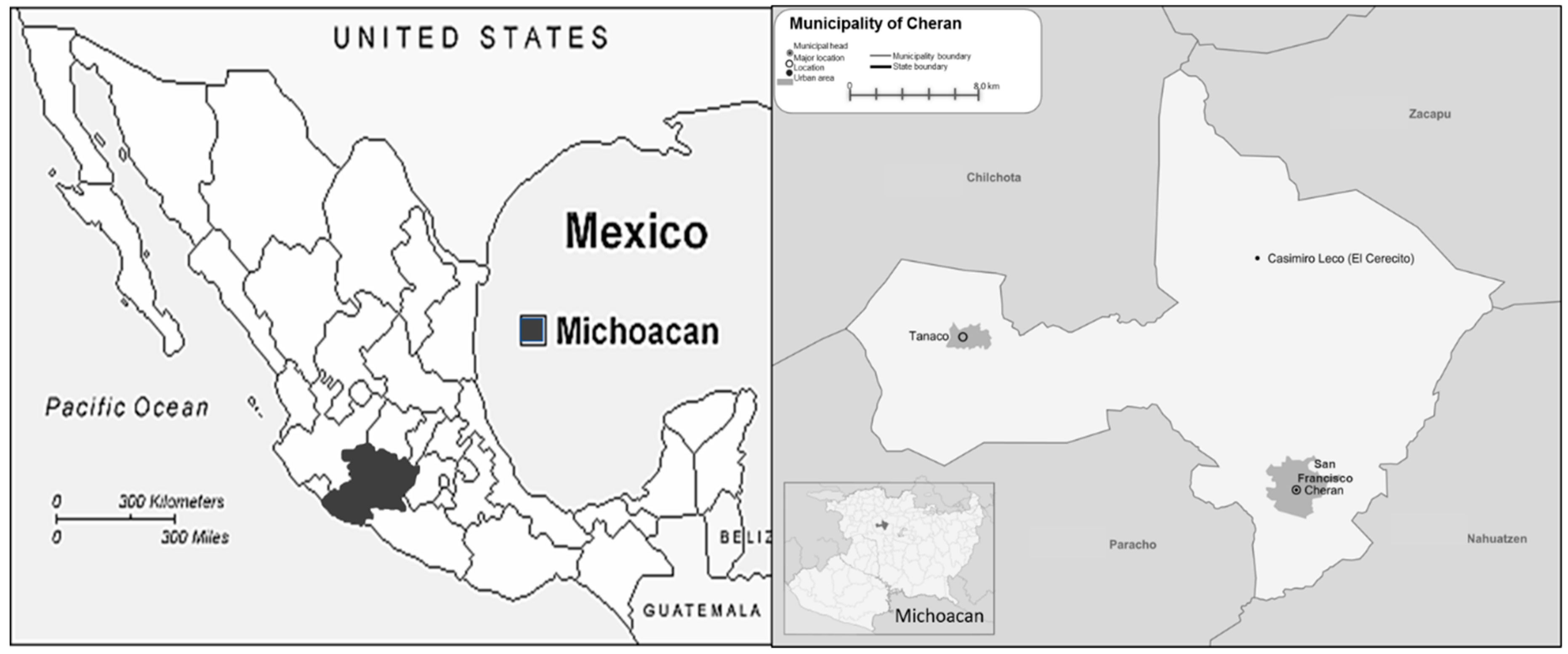
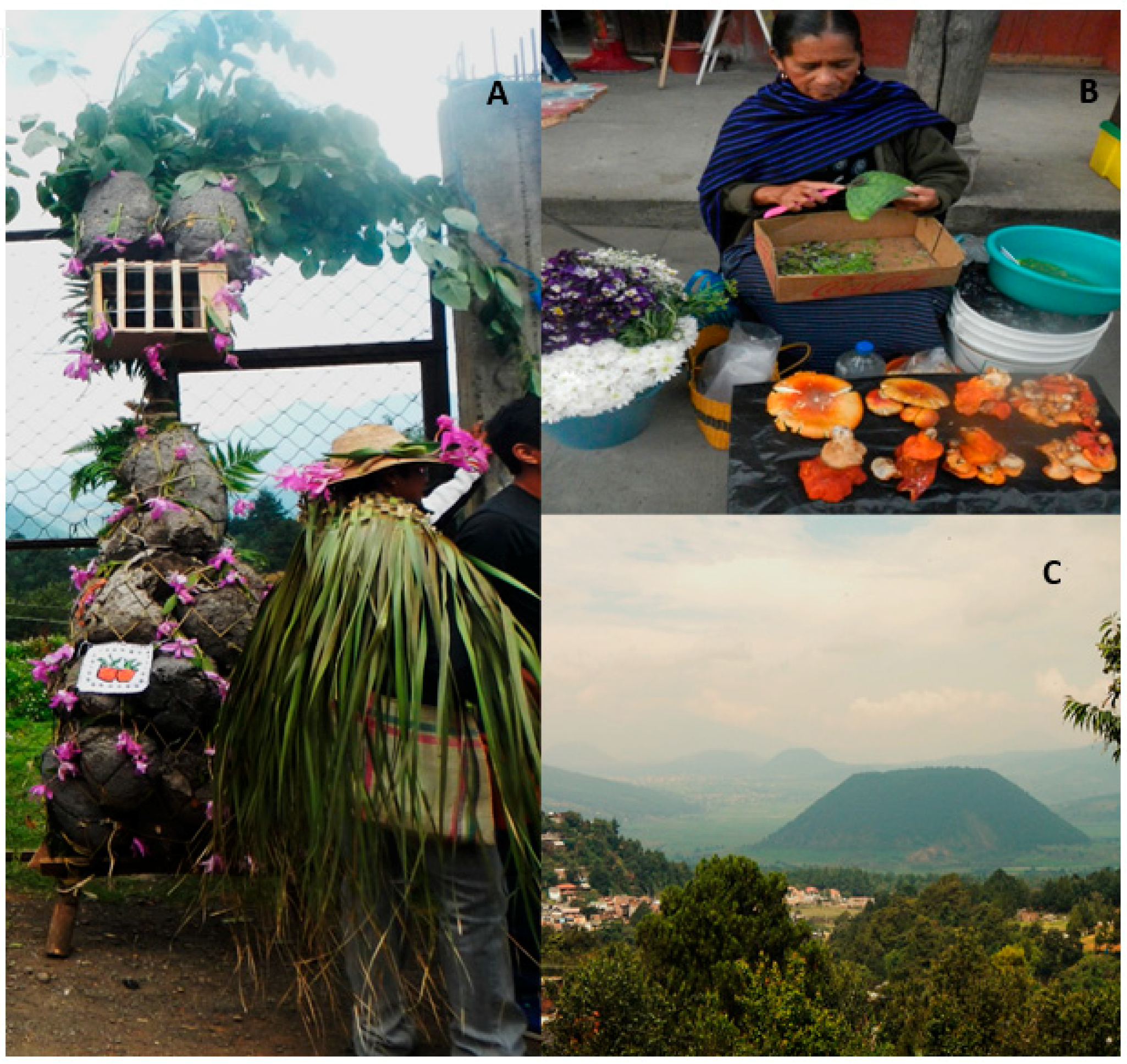
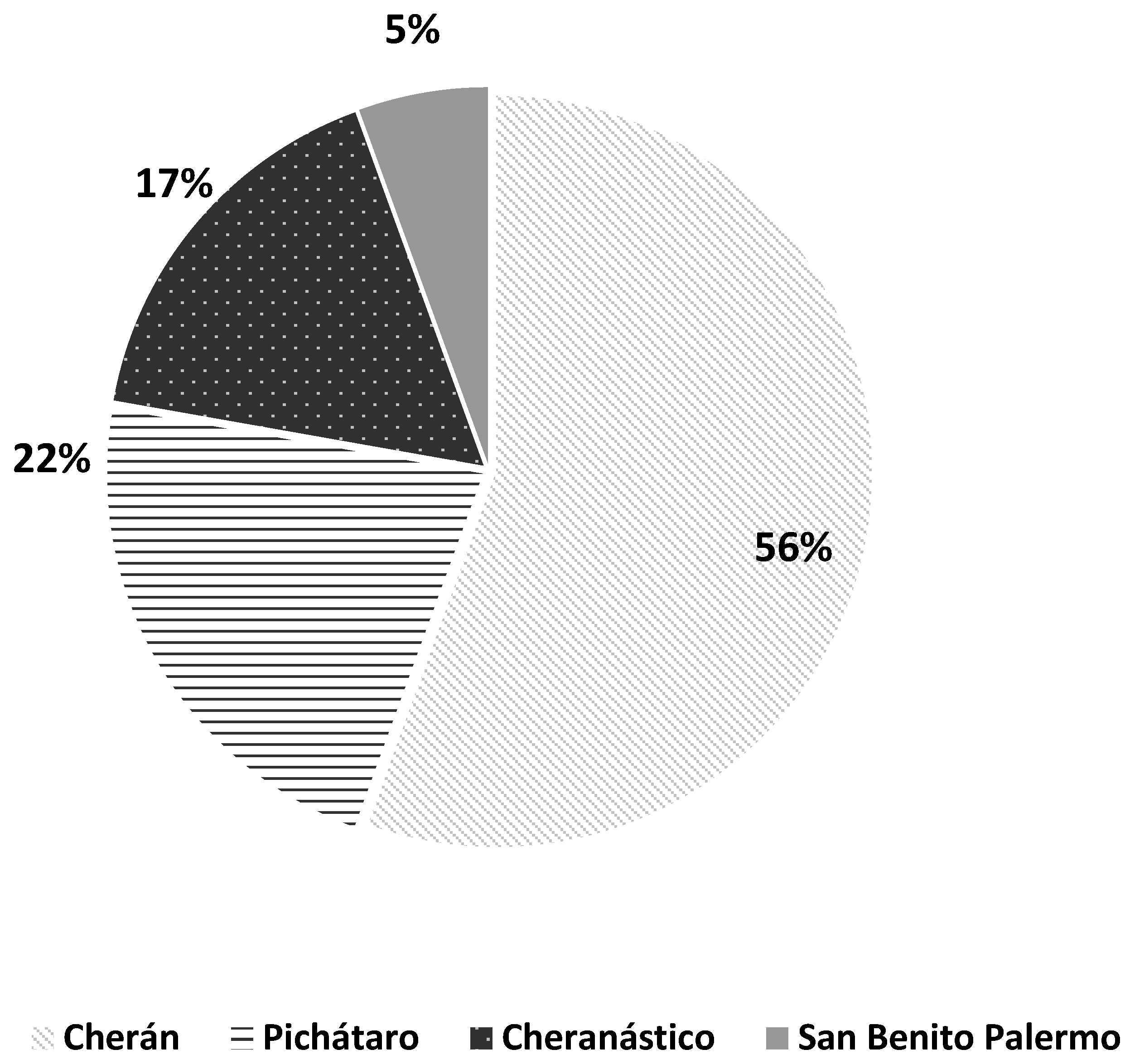
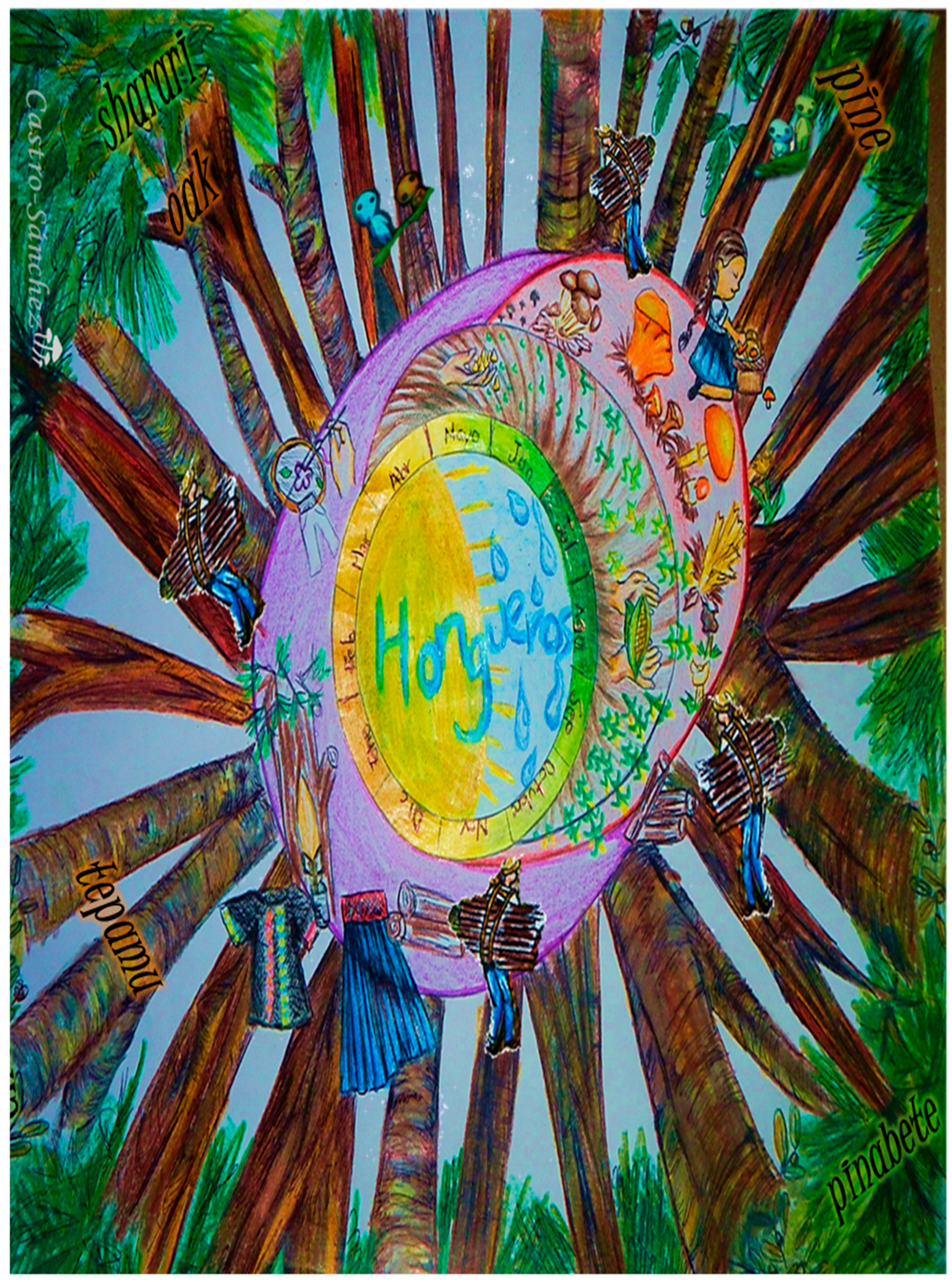
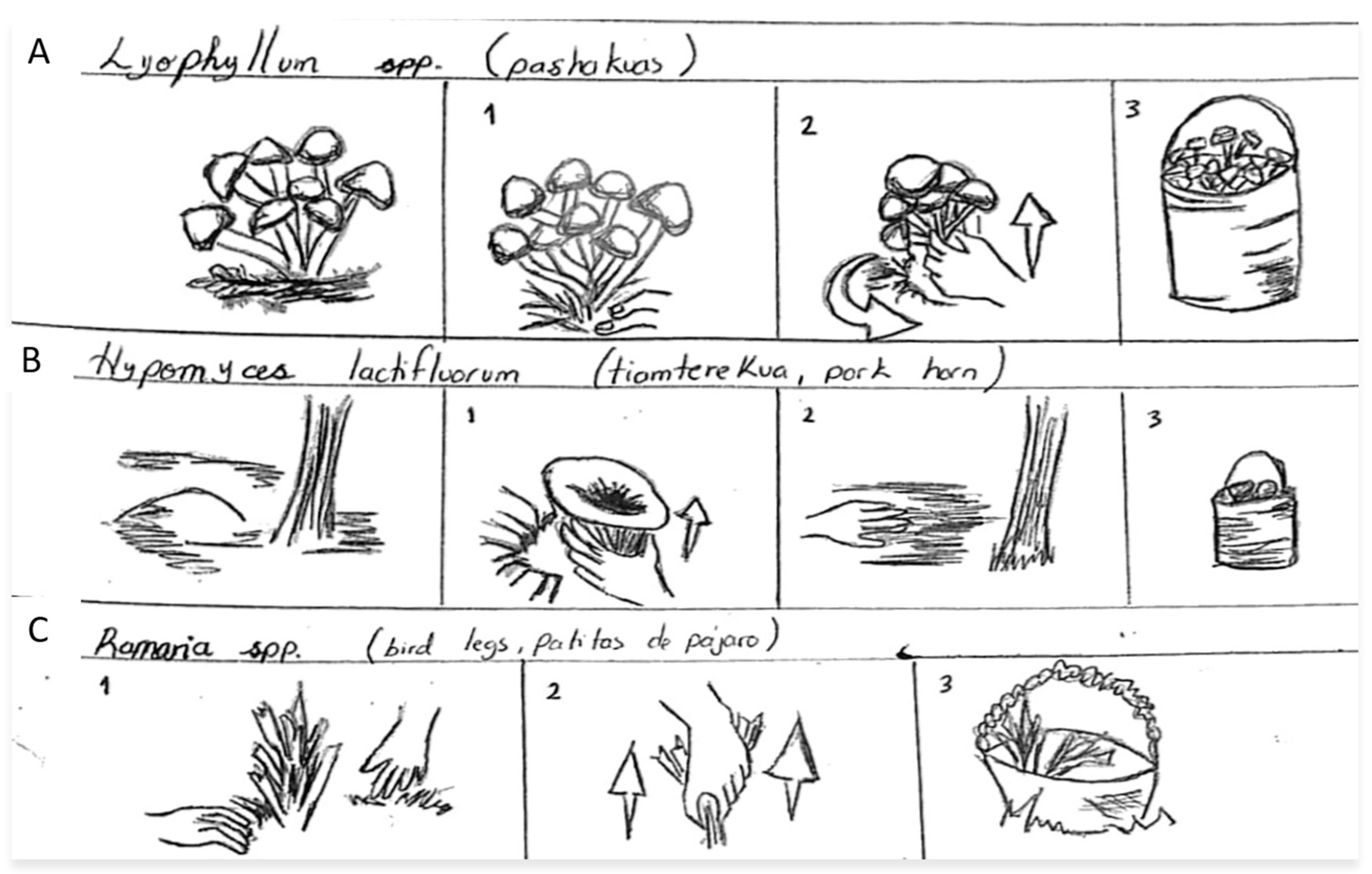
| Reference Number | Title | Description |
|---|---|---|
| [36] | Inventory of wild edible mushrooms from the community of El Aguacate south of the municipality of Tancitaro, Michoacán, Mexico. | Exploration of local mycological knowledge as well as the relationship between Russula brevipes and H. lactifluorum. The study found 16 species of edible wild fungi and described the common names of the parts of the fungi, as well as the related worldview. |
| [39] | Knowledge and popular use of wild macromycetes in the community of Arantepacua, a municipality of Nahuatzen, Michoacán, Mexico. | Compilation of 27 Purépecha names (i.e., 16 wild fungi species and 11 of the parts of an agarical) and of the most popular species, indicating the amount of extraction, their culinary value, and their preparation methods. |
| [30] | Ethnomycology and ecological aspects of edible mushrooms from San Juan Charapan, Michoacán. | Local ecological knowledge of edible wild fungi. An estimate of their diversity, abundance, and productivity in forest areas, as well as the influence of land-use changes and deforestation on the decline of fungi productivity. |
| [32] | Didactic guide for the identification of wild mushrooms from the community of Sevina, Michoacán. | Local ecological knowledge of edible wild fungi. An estimate of their diversity. Fungi distribution in nine types of vegetation: Conserved pine, disturbed pine, conserved oak–pine, oak–juvenile pine, tejocotal (Crataegus mexicana) scrub, adult cedar, juvenile pine, adult pine, trunks, milpa (maize, beans, and pumpkin polyculture), and slope. |
| [38] | Ethnoecology of the interchange of wild and weedy plants and mushrooms in Phurépecha markets of Mexico: Economic motives of biotic resources management. | Analyzed the relationships between the amounts of products exchanged, which were considered pressures on the resources; the perception of their abundance or scarcity, considered the magnitude of risk in relation to the pressures referred to; and the management types as a response to pressures and risk. |
| [21] | Local knowledge and economical significance of commercialized wild edible mushrooms in the markets of Uruapan, Michoacán, Mexico. | The most culturally significant species that are sold in markets of Uruapan, Michoacán, Mexico and the reasons behind these given values using frequency and order of the mentioned indexes. |
| Scientific Name | Purépecha Name/Local Name | Additional Information | Edible (E) or Poisonous (P) |
|---|---|---|---|
| A. caesarea (Scop.) Pers. | Tiripiti terekua, yellow | Tiripiti: “Golden;” terekua: “mushroom” | E |
| Amanita muscaria (L) Lam. | Chets, sweetened bread | - | P |
| Amanita virosa Secr. | White | - | P |
| Boletus aff edulis Bull. | Panterekua or Pan terekua, the belly, the belly of an ox, the belly of an old woman, bread | Pan terekua: Mushroom in the form of bread. From Spanish pan (bread) | E and medicinal |
| Cantharellus cibarius Fr. | Pig horn jeramba | Jeramba: “Bad,” “poisonous,” “wild” | E and P |
| Clitocybe gibba (Pers.) P.Klum | Small beans | E | |
| Gymnopus dryophilus (Bull.) Murrill | False small beans | - | P |
| Neolentinus spp. Redhead and Ginns | Yarinterekua or iarhini terekua, yarin, mushroom, little eagle | Iarini: “Mature pine,” iarini terekua: Variety of edible fungus that grows on old sticks (Velasquez Gallardo, 1978) | E |
| H. crispa Bull. | Sirat agants or siráata angánts terekua, mouse little ears | Sïrata anha-ntsï terekua: Erect-head smoke or smoke standing on top, variety of edible fungus (now written sïrata anhantsï) | E |
| Helvella lacunose Afzel | Sirat agants or siráata angánts terekua jeramba | Sïrata anha-ntsï terekua jeramba: Erect-head smoke wild mushroom, “not good” | E and P |
| H. lactifluorum (Schwein.) Tul. and C. Tul. | Tiámu terekua, horn pig | Tiámu terekua: Tiámu “iron,” terekua “mushroom” | E |
| Laccaria laccata (Scop.) Cooke | Small beans | - | E |
| L. loricatum (Fr.) Kühner | Huashikuas, pashakuas, huachikuas | Paxa-: Division of roads [51]. Uáxikuas or uáchikuas are variants of the same word and -s is the plural in Spanish, it appears as uáchitas or “small cumulus” [6]. For Diccionario Grande, uacheni means “to be many.” Now, the words for “a lot” are uá-nekua and uá-ni, which have the root ua- “a lot.” For Delfina Duran, inhabitant of Cherán, this means “ladies,” as they are always in groups. | E |
| Lyophyllum decastes (Fr.) Singer | Huashikuas, pashakuas, huachikuas | E | |
| Lycoperdon perlatum Pers. | Caca de nana kutsi. Mother Moon poo | Nana kutsï: “Mother Moon” | E |
| R. aff rubiginosa Marr and D.E. Stuntz | Kuinit jantsiri terekua. Bird’s paw coffee | Kuinitu jantsiri: “Little bird’s paw” | E |
| R. flava (Schaeff.) Quel. | Kuinit jantsiri terekua. Bird’s paw yellow (sweet smell) | - | E |
| Ramaria formosa (Pers.) Quel. | Kuinit jantsiri terekua jeramba. Bird’s paw light yellow | - | P |
| Ramaria aff flavigelatinosa Marr and D.E. Stuntz | Kuinit jantsiri terekua. Bird’s paw white | - | E |
| R. brevipes Peck. | Pig’s trunk, jeramba | - | P |
| Sparassis crispa Marr and D.E. Stuntz | Oxen yoke | - | E |
| Species | Preference by Flavor | Income (250 g/dollar) |
|---|---|---|
| Amanita caesarea | ||||| | 2.55–5.10 |
| Boletus aff edulis | ||| | - |
| Chantarellus cibarius | | | - |
| Clitocybe gibba | | | - |
| Neolentinus spp. | ||||| | - |
| Helvella crispa | ||| | 1.02 |
| Helvella lactifluorum | |||||| | 1.27–5.10 |
| Laccaria loricatum | ||| | 1.02–2.55 |
| Laccaria descastes | ||| | 1.02–2.55 |
| Laccaria perlatum | | | - |
| Ramaria aff rubiginosa | ||| | 1.02 |
| Ramaria flava | ||| | 1.02 |
| Ramaria botrytis | ||| | 1.02 |
| Ramaria aff flavigelatinosa | ||| | 1.02 |
| Sparassis crispa | ||| | 5.02–12.74 (by size) |
| Wild Fungi Species | Vegetation Type or Habitat |
|---|---|
| Amanita muscaria | Pinadas (Sets of young pines, mainly P. aff leiophylla) |
| Amanita virosa | |
| Boletus aff edulis | |
| Cantharellus cibarius | |
| Clitocybe gibba | |
| Gymnopus dryophilus | |
| Laccaria laccata | |
| Ramaria aff rubiginosa | |
| Ramaria flava | |
| Ramaria formosa | |
| Ramaria aff flavigelatinosa | |
| Ramaria brevipes | |
| Sparassis crispa | |
| Neolentinus spp. | Rotten tree trunks Pineland/grassland/cedar forest |
| Helvella crispa | |
| Helvella lacunose | |
| Helvella lactifluorum | Tepamu vegetation (A. aff acuminata) or Pinada |
| Laccaria loricatum | Holm oaks (Q. crassipes) |
| Lyophillum descastes | Sharari vegetation (Q. aff laeta) |
| Lycoperdon perlatum | Oaks and grassland |
© 2019 by the authors. Licensee MDPI, Basel, Switzerland. This article is an open access article distributed under the terms and conditions of the Creative Commons Attribution (CC BY) license (http://creativecommons.org/licenses/by/4.0/).
Share and Cite
Castro-Sánchez, E.I.; Moreno-Calles, A.I.; Meneses-Eternod, S.; Farfán-Heredia, B.; Blancas, J.; Casas, A. Management of Wild Edible Fungi in the Meseta Purépecha Region, Michoacán, México. Sustainability 2019, 11, 3779. https://doi.org/10.3390/su11143779
Castro-Sánchez EI, Moreno-Calles AI, Meneses-Eternod S, Farfán-Heredia B, Blancas J, Casas A. Management of Wild Edible Fungi in the Meseta Purépecha Region, Michoacán, México. Sustainability. 2019; 11(14):3779. https://doi.org/10.3390/su11143779
Chicago/Turabian StyleCastro-Sánchez, Eva Itzel, Ana Isabel Moreno-Calles, Sue Meneses-Eternod, Berenice Farfán-Heredia, José Blancas, and Alejandro Casas. 2019. "Management of Wild Edible Fungi in the Meseta Purépecha Region, Michoacán, México" Sustainability 11, no. 14: 3779. https://doi.org/10.3390/su11143779
APA StyleCastro-Sánchez, E. I., Moreno-Calles, A. I., Meneses-Eternod, S., Farfán-Heredia, B., Blancas, J., & Casas, A. (2019). Management of Wild Edible Fungi in the Meseta Purépecha Region, Michoacán, México. Sustainability, 11(14), 3779. https://doi.org/10.3390/su11143779






